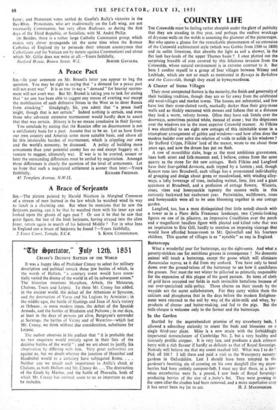k Cluster of Stone Villages Their most unexpected feature is
the maturity, the finish and generosity of their building tradition, though they are so far away from the celebrated old wool-villages and market towns. The houses are substantial, and few have lost their stone-slatted roofs, markedly darker than their grey-stone walls and so thickly encrusted with mosses and lichens that at a distance they look-a warm, velvety brown. Often they have oak lintels over the doorways, sometimes painted white, instead of stone ; but the dripstones over the windows are in the most superior Cotswold manner. At Filkins I was electrified to see eight new cottages of this inimitable stone in a triumphant arrangement of gables and windows—and how often does-the modern builder ever solve the relation of voids to solids in his windows 7 Sir Stafford Cripps, Filkins' lord of the manor, wrote to me about these years ago, and now the dream has put on flesh.
A row of monolithic slabs, huge as the most ambitious gravestones, lines both street and folk-museum and, I believe, comes from the same quarry as the stone for the new cottages. Both Filkins and Langford have their four-gabled dovecots, each topped by a lantern ; and, though Kencot runs into Broadwell, each village has a pronounced individuality of grouping and design about green or meadowland, with winding alley- ways, a lofty bowerage of trees, including walnut, lime, ilex and a giant sycamore at Broadwell, and a profusion of cottage flowers.
roses, vines and honeysuckle tapestry the austere walls in this curiously backward but exuberant year. Periwinkles, wallflowers, roses and honeysuckle were all to be seen blooming together in one cottage garden.
Langford, too, has a most distinguished (but little noted) church with a tower as in a Piero della Francesca landscape, two Cymric-looking figures on one of its pilasters, an impressive Crucifixion over the porch and a° magnificent headless figure with pleated and kilted robe that was an inspiration to Eric Gill, hardly to meution an imposing vicarage that would have afforded house-room to Mr. Quiverfull and his fourteen children. This quartet of villages is as "eyeable" as any in England.






































 Previous page
Previous page